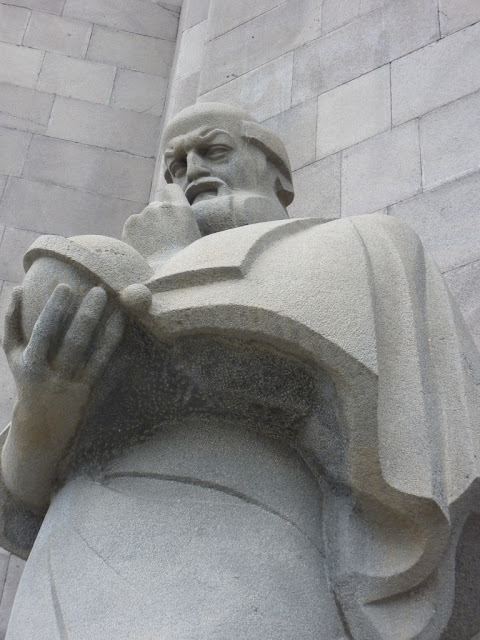 |
| Mother Armenia (formerly Father Stalin), conveniently loced next to a Soviet era theme park. |
This weekend I visited Yerevan and some of the surrounding sites.
 |
| Train Station |
 |
| King Argishti I of Urartu, founder of Erebuni Fortress and Yerevan |
 |
| The Urartu Kingdom was centered around Lake Van (in modern day Turkey). It existed from ~900-600 B.C. |
 |
| The protector of the Erebuni Museum. |
 |
| Cuneiform: "By the glory of the God Khaldi, Sarduri son of Argishti built this granary." |
 |
| One of the two supreme gods of the Urartu religion |
 |
| There was plenty of graffiti at the fortress. |
 |
| Erebuni Fortress is also called the Fortress of Blood. |
 |
| Cuneiform amid the walls |
 |
| The view from Erebuni Fortress. Yerevan is called the Pink City because of the local pink granite commonly used as a building material. |
 |
| The Metsamor Nuclear Power Plant produces around 40% of Armenia's electricity... and is the oldest model of nuclear power plant. The Armenians like to live dangerously. |
 |
| Countryside next to Yerevan |
 |
| The Cascade. Inside is an escalator surrounded by modern art exhibitions. Behind the Cascade is the Monument to the 50th Anniversary of Soviet Armenia. |
 |
| A statue made by Fernando Botero. I think he has a nice mustache. |
 |
| The Matenadaran is one of the leading ancient manuscript repositories in the world. |
 |
| So wise. |
 |
| A 10th century Bible with an ivory binding. |
 |
| An Armenian map from the 12th century showing the world to be round, with Jerusalem at its center. Definitive evidence of Earth's shape wasn't available until the 16th century after Magellan circumnavigated the globe. |
 |
| A translation of the map. |
 |
| BAMF |
 |
| Though Yerevan looks pretty Soviet and dour from far away, the center of the city is quite pleasant, and of similar quality to a Western European capital. |
 |
| The city wasn't without its quirks. I'm of the opinion you shouldn't mix stuffed animals and cigarettes in claw machines. |
 |
| The Beretta store on the main street. |
 |
| The Armenian Genocide Memorial (Tsitsernakaberd). The museum here proves beyond a reasonable doubt (with, among other things, graphic pictures) that the Young Turks, the ruling party of the Ottoman Empire during World War I, perpetrated a genocide against the Empire's Armenian minority. That being said, it is unfortunate that no context is given to the Armenian Genocide (the Armenians sided with the Russians during the war in an attempt to break away from the Ottoman Empire, and ~200,000 Armenians fought for the Russians) and that Allied propaganda against the Ottoman Empire is used to supplement the historic proof of the Genocide. |
 |
| A soundtrack of an Armenian woman singing laments for the dead plays at this touching memorial. |
 |
| The Karen Demichyan Complex, also known as Dr. Seuss's Mansion, unfortunately located next to the Genocide Memorial. |
 |
| St. Sargis Vicarial Church, a good example of Armenian religious architecture |
 |
| I also took a tour of the world famous Yerevan Brandy Company, which produces Ararat Congac (now relegated to a brandy because of French snobs). |
 |
| The company was state owned until 1998 when it was privatized and sold to French investors. |
Yerevan has the most value of any city I have been to. There is a plethora of historic sites to visit, the night life is excellent, and the restaurants are delicious and diverse. It costs $15-$30 a night for a decent hotel, $5 for a meal at a nice cafe, and $1 for a 30 km bus ride. With so much to do and see at so little cost, I plan on returning once more before I leave the Caucuses.




























































